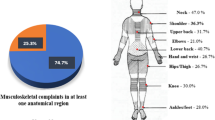Abstract
Objectives: This study analysed the association between gender and upper extremity musculoskeletal complaints, among the general working population and in various occupational groups. The hypothesis was tested whether the higher risk for women in the general working population for these complaints could partly be explained by differences in the distribution of men and women in occupations with different risks for the onset of upper extremity musculoskeletal complaints. Methods: The data for this study came from cross-sectional questionnaire data from 16,874 employees categorised in 21 different occupational classes. Associations between gender and complaints of the upper extremities were analysed for the total study sample and for each occupational class separately. An adjustment was made for the variable `occupational class' in the final model in order to study the impact of occupational gender segregation on gender differences in upper extremity complaints in the working population. Results: In the total study sample, significantly higher risks of complaints of the neck, shoulder, elbow, and wrist among the women were observed. Within many occupational classes, women reported significantly higher risks than did men, in particular for complaints of the neck and shoulder. Adjustment for occupational class showed increased risks for female workers for complaints of the neck, shoulder, elbow, and wrist, hence, rejecting our hypothesis on occupational gender segregation as an explanation for the higher risks for upper extremity complaints among women in the general working population. Conclusions: This study confirmed the presence of gender differences in upper extremity musculoskeletal complaints among the working population and in many occupational classes, with female workers having the higher risk. The results, however, do not lend support to a differential occupational exposure theory as an explanation for the higher risks for these complaints among women in the general working population. Careful consideration of gender influence in ergonomic epidemiological studies is recommended.
Similar content being viewed by others
Author information
Authors and Affiliations
Additional information
Received: 16 February 2000 / Accepted: 10 June 2000
Rights and permissions
About this article
Cite this article
de Zwart, B., Frings-Dresen, M. & Kilbom, Å. Gender differences in upper extremity musculoskeletal complaints in the working population. Int Arch Occup Environ Health 74, 21–30 (2000). https://doi.org/10.1007/s004200000188
Issue Date:
DOI: https://doi.org/10.1007/s004200000188




